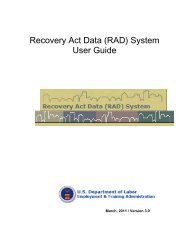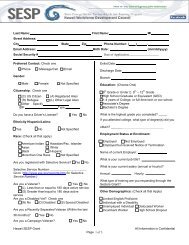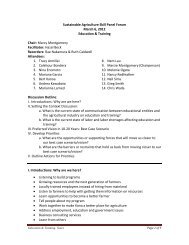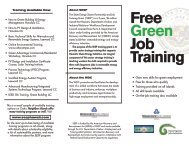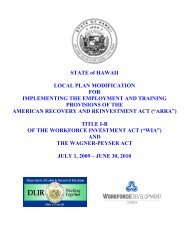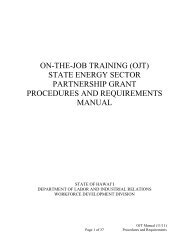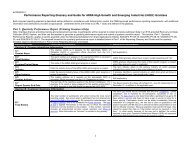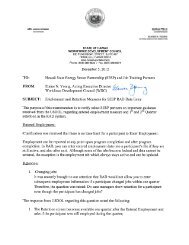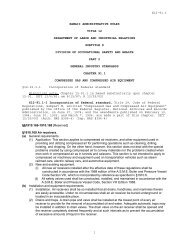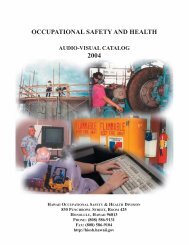Hawai i's Green Workforce A Baseline Assessment December 2010
Hawai i's Green Workforce A Baseline Assessment December 2010
Hawai i's Green Workforce A Baseline Assessment December 2010
Create successful ePaper yourself
Turn your PDF publications into a flip-book with our unique Google optimized e-Paper software.
Conclusion<br />
The green economy in <strong>Hawai</strong>ÿi is sizable and<br />
positioned to grow rapidly. Fueling this trend is<br />
consumer demand for goods and services that are<br />
carbon-neutral or low impact on the environment.<br />
Businesses are responding to this niche market by<br />
developing production processes and delivery systems<br />
that consider factors beyond profit maximization.<br />
While these intentions may be well placed, our<br />
knowledge of the environment and the role that<br />
humans play in it remains limited and is still evolving.<br />
Technologies that can reduce our ecological footprint<br />
also require costly research and, in some cases,<br />
complex infrastructure. To effectively respond to<br />
these challenges, policy makers and community<br />
leaders must cultivate an educated and skilled<br />
workforce capable of meeting the needs of a cleanenergy<br />
economy.<br />
Data from the inaugural <strong>Hawai</strong>‘i <strong>Green</strong> Jobs Survey<br />
indicate that green jobs are expected to increase from a<br />
2.4 percent share of total private employment in <strong>2010</strong><br />
to 2.9 percent by 2012. Such growth will bring on line<br />
2,903 new green jobs statewide, a 26 percent increase<br />
in just two years. This contrasts with a one percent<br />
average increase in total State employment over the<br />
same period. 11 Given our findings that green jobs exist<br />
in a large array of industries, ranging from traditional<br />
sectors such as agriculture and construction to high<br />
technology ventures in bio-fuels and hydrothermal,<br />
a growth rate differential of this magnitude can have<br />
profound social and economic implications<br />
Labor market participants will require the tools and<br />
resources to transition to a greener economy. This will<br />
include retraining on-the-job or through certification<br />
and licensing. Enrollment in formal degree programs<br />
may be necessary if workers are to pursue entirely new<br />
careers, either by choice or through underemployment<br />
11 DLIR Research & Statistics Office, Long-Term Industry<br />
Projections, State, 2008-2018, <strong>2010</strong>. The overall increase is<br />
based on first quarter <strong>2010</strong> non-government employment of<br />
467,443 and projected 2012 employment of 476,835.<br />
Photo Courtesy of Kauaÿi County Recycling<br />
or unemployment. The associated costs, both direct<br />
and indirect, can be significant, particularly during the<br />
current period of post-recession economic recovery.<br />
Success will require active coordination among all<br />
stakeholders. Educators and training providers must<br />
provide timely and relevant curricula; policy makers<br />
will need to provide support in the form of funding<br />
and a strategic plan that can deliver on its ambitious<br />
HCEI goals; business leaders should continue to<br />
actively incorporate greener practices and processes<br />
into their production platforms; and workers or those<br />
seeking employment will need to update existing skills<br />
and competencies to maintain their competitiveness.<br />
This report provides the first comprehensive<br />
assessment of <strong>Hawai</strong>i’s green workforce.<br />
Employment patterns and vacancy trends are analyzed<br />
at the state and county levels across all major groups<br />
of industries, occupations and worksite sizes. <strong>Green</strong><br />
is an evolving concept that is better understood<br />
when considered within the context of a larger labor<br />
market information (LMI) system. Connecting the<br />
data collected on green jobs with broader LMI-use<br />
dynamics and best practices will be an essential<br />
next step. Such efforts are currently underway, and<br />
encompass two additional areas:<br />
<strong>Hawai</strong>ÿi’s <strong>Green</strong> <strong>Workforce</strong>: A <strong>Baseline</strong> <strong>Assessment</strong> 47



